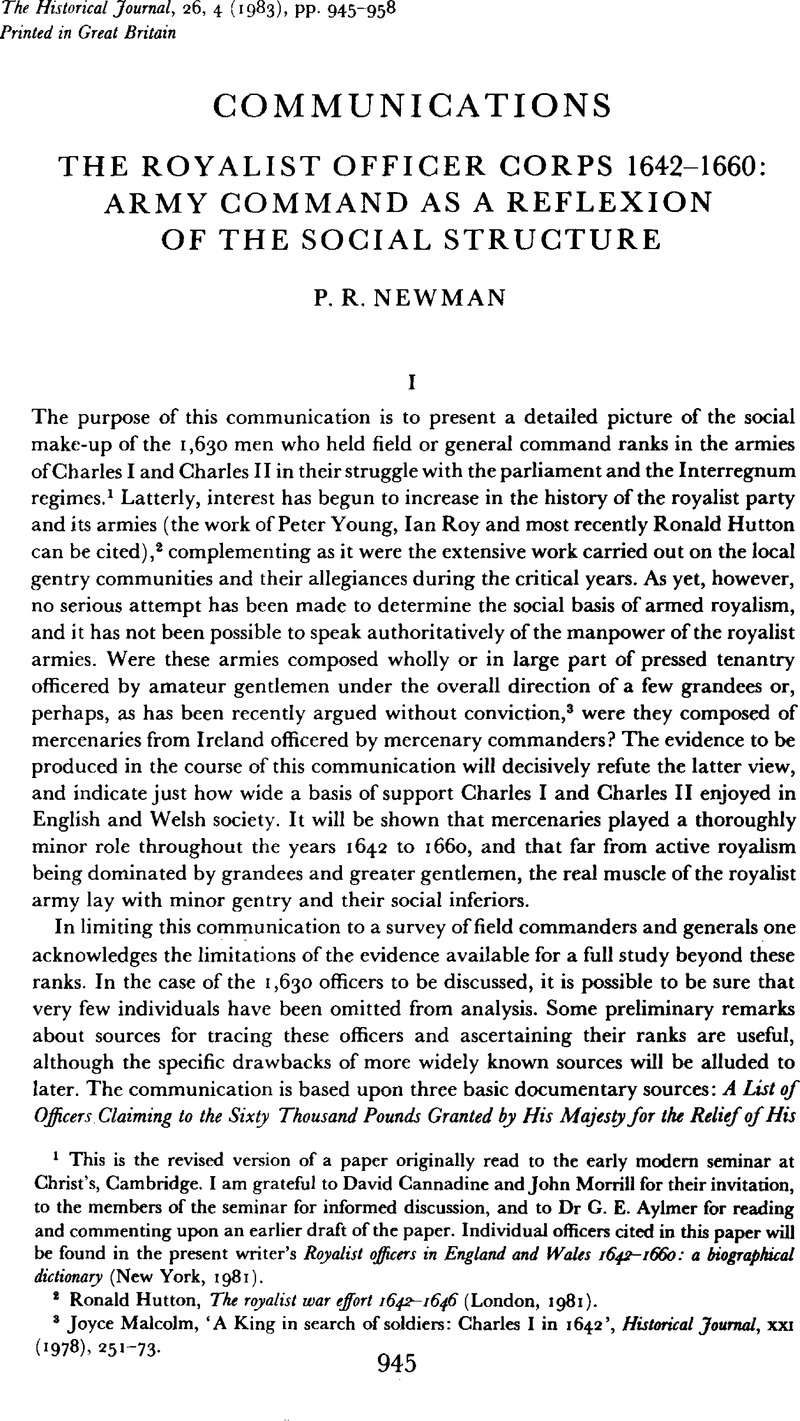Published online by Cambridge University Press: 11 February 2009

1 This is the revised version of a paper originally read to the early modern seminar at Christ's, Cambridge. I am grateful to David Cannadine and John Morrill for their invitation, to the members of the seminar for informed discussion, and to Dr G. E. Aylmer for reading and commenting upon an earlier draft of the paper. Individual officers cited in this paper will be found in the present writer's Royalist officers in England and Wales 1642–1660: a biographical dictionary (New York, 1981).Google Scholar
2 Ronald, Hutton, The royalist war effort 1642–1646 (London, 1981).Google Scholar
3 Joyce, Malcolm, ‘A King in search of soldiers: Charles I in 1642’, Historical Journal, xxi (1978), 251–73.Google Scholar
4 I have consulted Brigadier Peter Young's own copy, but there is one in the Public Record Office, SP 29/168.
5 Bodleian Library MS Eng. hist e 309.
6 Anthony, Fletcher, The outbreak of the English Civil War (London, 1981), pp. 166, 181, 258. One of the men who may have accompanied Charles I on his mission was the lawyer William Mason, a Norfolk man who had married money. He was subsequently knighted and a colonel of horse in the army of the earl of Newcastle, see Newman, Royalist officers, p. 248.Google Scholar
7 See, for example, the experience of Sir Henry Slingsby in Parsons, D. (ed.), Diary of Sir Henry Slingsby (London, 1836), pp. 82, 87.Google Scholar
8 Fletcher, Outbreak, p. 50.
9 Fisher, F. J. (ed.), Thomas, Wilson, ‘The State of England Anno Dom. 1600’, Camden Miscellany, xvi, Camden Society 3rd Series LII, 1936, p. 24.Google Scholar
10 See the case of Henry Wait in Newman, Royalist officers, p. 394 and in M. A. E. Green, Calendar of the Proceedings of the Committee for Advance of Money, 1888, pp. 839/840.
11 For Beeton and Jennings see British Library Harleian MS 986 fos. 92 b, 93 b.
12 Sir Thomas Smith, Republica Anglorum, 1585, p. 27.
13 Anderson, M. D., History and imagery in British churches (London, 1971), p. 211 noticed the (?sixteenth-century) memorial to Robert Chapman at Stone in Kent, ‘what tyme he lyvved was he Esquier and Marchaunte Venturer of London Draper free’, but see also the heraldic denial of gentility to the rich merchant father of Lt-Colonel Sir Nicholas Cole: Newman, Royalist officers, p. 76 and references there cited.Google Scholar
14 In determining social status below that of titled ranks, I have tended to follow DrBlackwood, (The Lancashire gentry and the Great Rebellion 1640–1660 [Manchester, 1978]) in accepting heraldic definition of esquires and accepting the use of the term ‘gentleman’ when applied by contemporaries to a given individual. Protestation returns, quarter sessions records, freeholders’ lists and other sources such as private correspondence and composition proceedings have been used where extant in tracking down individuals. Another useful source is Sir William Dugdale's lists of commissioners of array in Finch Hatton MS 133, Northants Record Office. The success rate is indicated by the figures in the text.Google Scholar
15 For M.P.s and sheriffs I have used the published Public Record Office lists. J.P.s and deputy-lieutenants may be tracked down in the State Papers and in quarter sessions and in other county archival material.
16 I have relied here upon Foster, Alumni Oxonienses 1500–1714 (repr. 1968), and Venn and Venn, Alumni Cantabrigienses Part 1 (Cambridge, 1922).Google Scholar For the older generation of royalist commanders sec A., Clark (ed.), Register of the University…, vol. 11 (Oxford Historical Society, 1885–9). These sources are useful for those who passed on to the Inns of Court supplemented by various published admissions registers.Google Scholar
17 For Dalbere or Dalbier see Newman, Royalist Officers, p. 99 and also Calendar of State Papers 1644, pp. 69, 504.
18 Newman, P. R., ‘Catholic Royalist activists of Northern England 1642–5’, Northern History, xv (1979), 88–95CrossRefGoogle Scholar and ‘Roman Catholic royalists: Papists as commanders under Charles I and Charles II’, Recusant History, xv, no. 6 (1981), 396–405.Google Scholar
19 Malcolm, ‘A king in search of soldiers’.
20 ibid.
21 John, Morrill, ‘The Northern gentry and the Great Rebellion’, Northern History, xv (1979), 74.Google Scholar
22 See, for example, Blackwood, Lancashire gentry, and John, Morrill, Cheshire 1630–1660 (Oxford, 1974), p. 223Google Scholar and passim; Alan, Everitt, The community of Kent and the Great Rebellion (Leicester, 1966), p. 143;Google ScholarDavid, Underdown, Somerset in the Civil War and Interregnum (Newton Abbot, 1973), p. 124.Google Scholar
23 Fletcher, Outbreak, p. 419.
24 Joan, Thirsk, ‘Younger sons in the 17th century’, History, LIV (1969), 373.Google Scholar
25 This seems to be borne out by David, Underdown, Royalist conspiracy in England (Yale, 1960).Google Scholar
26 For Brett see Newman, Royalist officers, p. 41 and for example, CSPD 1661/2, p. 529, 1663/4, PP- 504, 654, and 1664/5, p. 42. For Webbe see Newman, Royalist officers, p. 401 and, for example, CSPD 1663/4, a letter urging his case written by more prominent royalist gentry who never attained to Webbe's military seniority.